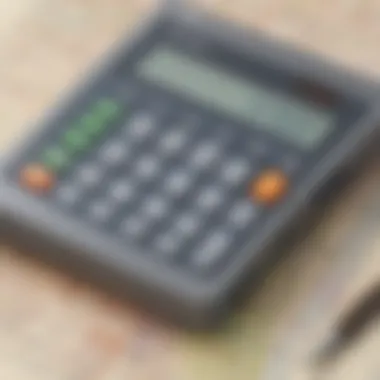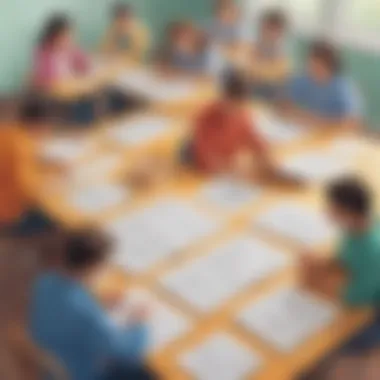Mastering Area Calculations: Simplification and Tools


Intro
Calculating areas is an essential skill in mathematics. Understanding how to find the area of different shapes can help learners grasp more complex concepts later. This guide aims to present the fundamental methods necessary for mastering area calculations. Furthermore, we will delve into essential techniques for simplifying mathematical expressions. The use of modern tools, such as calculators and software, also plays a significant role in achieving accurate results.
Creative Activities
Engaging in practical activities reinforces learning. Creative projects can make the process of learning about area calculations much more enjoyable.
Craft Ideas
Children can replicate several projects to reinforce area concepts. A simple shape collage is one idea. Collect different colored papers that take forms of squares, triangles, or circles. By cutting and pasting the shapes onto a board, kids can visually understand different areas. Additionally, using tools like scissors for cutting shapes reinforces fine motor skills.
Step-by-Step Guides
- Prepare Materials: Gather paper, scissors, glue, and a measuring ruler.
- Choose Shapes: Decide which shapes to create. A square and a triangle are recommended.
- Measure and Cut: Measure appropriate dimensions using a ruler. Cut out the desired shapes.
- Assemble: Glue the shapes onto a larger sheet in a way that shows different combinations.
- Calculate Areas: Discuss how to calculate the area of each shape using the formulas. Use this exercise to apply the learned techniques.
Educational Value
Participating in these activities enhances understanding of spatial awareness. Children can see the transition from a physical representation to abstract forms, making mathematical concepts much clearer. It fosters curiosity and allows children to engage actively with their learning environment.
Fun Quizzes
Quizzes serve a unique purpose in consolidating knowledge acquired. These challenges can be fun and educational, allowing learners to assess their understanding.
Quiz Topics
Available quizzes could include topics such as:
- Area of rectangles
- Area of triangles
- Composite shapes and how to calculate their areas
Question Types
The diversity in quiz question types can include:
- Multiple-choice questions
- Fill-in-the-blank exercises
- Short answer inquiries to encourage free-thinking
Knowledge Reinforcement
Quizzes can significantly aid in cementing foundational knowledge. As children take these quizzes, they not only test their understanding but also discover areas that need more focus. Encouragement to revisit the materials fosters growth in despising confusion.
Fact-Based Articles
Research articles contain relevant information that can expand knowledge. Accessing diverse articles promotes continuous learning.
Topics
Articles could cover:
- Calculation methods for different shapes
- Practical applications of area in real-life scenarios
- Historical mathematicians and their contributions to geometry
Engaging Content
Presenting information in a digestible manner encourages children's interests. Simple language paired with informative illustrations helps clarify concepts effectively.
Prolusion to Area Calculation
Understanding area calculation is fundamental in mathematics. Area helps define the space covered by a shape. This notion is crucial for various applications in life, like measuring spaces in construction or design projects. Adequate comprehension of area also aids in grasping more complex mathematical concepts in the future.
What is Area?
Area may conceptualized simply as the size of a surface. It is measured in square units, which show the extent of a two-dimensional space. For squares and rectangles, finding the area is relatively straightforward. For instance, multiplying length by width provides the result. Triangles, circles, and more elaborate forms have distinct methods to find their area, requiring a good grasp on formulas and principles. These calculations are a significant element of geometry, intersecting practical usage and theoretical study.
Importance of Area in Mathematics
The importance of area extends beyond mere calculations.


- Foundation for subsequent geometry topics: Without understanding area, topics like volume or perimeter might be confounding. It sets a base upon which future learning can occur.
- Real-world applicability: Professionals in architecture, engineering, and diverse spatial planning fields rely on accurate area calculations. Therefore, comprehending area impacts daily tasks and challenges.
- Enhancing critical thinking: Solving for area teaches problem-solving skills cognitive skills valued immensely.
Understanding and applying area can transform one’s approach to practical and academic challenges.
Understanding Different Geometric Shapes
Understanding different geometric shapes is crucial for effective area calculation. Each shape has unique properties and area formulas. For example, rectangles are defined by their length and width, while circles have a radius. Knowing these fundamental distinctions helps in correctly applying formulas and simplifying calculations. This section helps learners recognize patterns in shapes, enhancing their mathematical reasoning skills.
Rectangles and Squares
Formulas for Area Calculation
The formulas for calculating the area of rectangles and squares are direct and easy to understand. For a rectangle, the area is calculated by multiplying length by width. For a square, which is essentially a special type of rectangle, the formula simplifies to width squared. The straightforward nature of these formulas makes them ideal for introducing mathematical concepts to younger learners. Schools often use these shapes because students can visualize them easily in their daily environment.
- Key point: The calculation relies on direct multiplication, making it less prone to errors.
- Unique feature: A square's formula is a simple application of one measurement, reducing complexity.
However, it's important for users to check if they have the right dimensions. Confusion often erupts with units like meters versus centimeters.
Examples and Exercises
Examples and exercises are vital for mastering area calculations. Provided scenarios that ask learners to calculate the area of specific rectangles or squares help reinforce the concepts. This practice enhances retention and builds confidence. Students can also use these examples in practical settings, relating maths back to tasks around the house or school.
- Key point: Engaging with examples allows learners to see theoretical knowledge in practical scenarios.
- Unique feature: Exercises vary in difficulty, catering to differing levels of ability.
Nevertheless, lack of clarity in wording can confuse learners. It's essential exercises are clear and students understand what is being asked of them.
Triangles
Calculating Area with Base and Height
Calculating the area of triangles typically involves using the base and height. The formula here is to take half the product of these measurements. This distinctive factor emphasizes that both measurements are necessary to determine the area correctly. This triangle aspect is particularly useful when working with map-based questions in geography.
- Key point: Understanding this formula offers insight into three-dimensional spatial reasoning.
- Unique feature: Students learn to visualize different orientations of triangles, which enriches their geometry understanding.
However, learners may sometimes forget the need to divide by two. This can lead to substantial miscalculations. Therefore, it's important always to verify their results.
Different Types of Triangles
Each type of triangle offers its flair. From equilateral to isosceles and scalene, students should understand how these differences influence properties. Exploration of the characteristics delivers depth to learning. Recognizing each type can assist with projects in symmetry and balance, crucial for career tasks like architecture or art.
- Key point: Encourages analytical skills in categorizing shapes and understanding their applications.
- Unique feature: Different triangles inform area calculation under various contextual styles, advancing versatility in problem-solving.
Nonetheless, the variations might confuse those who struggle with visual differentiation. Providing drawings can help solidify these concepts.
Circles
Understanding Radius and Diameter
The concepts of radius and diameter are fundamental. Understanding these terms and their relationships shape how area is determined . The radius is half the diameter, transitioning easily into secure calculations for circles. Even for simple drawings at home or in classrooms, knowing these aspects aids both computations and geometrical interests, like in outer design or movements that define futures.
- Key point: Recognizing the relationship helps in simplifying and recalling the necessary measurements.
- Unique feature: It connects to many applications in fields like physics and engineering, making it a practical focus.
Nevertheless, confusion between radius and diameter often leads to incorrect area calculations. Educational routines should reinforce these terminologies.
Formula for Area
The area of a circle is derived from its radius using the formula ( A = \pi r^2 ). This mathematical expression excels in its simplicity yet possesses far-reaching implications. Carpenters or craftsmen impressively apply it in real-world scenarios, like circular fences. Thus, understanding this area formula can impressively elevate practical skills.
- Key point: The familiarity with ( \pi ) allows students to relate area calculations broadly.
- Unique feature: Develops a useful connection to variables seen throughout life scenarios through technology and design apps.
On the downside, the constant irrationality of ( \pi ) can dishearten those uncomfortable with non-terminating decimals. Challenge lies in learning to adapt without discomfort.
Complex Shapes
Combining Shapes


The concept of combining shapes in area calculation opens avenues for intricate solutions. For instance, learners often need to break complex figures into simpler ones, allowing application of various formulas. Finding areas of irregular shapes can aid critical aspects like landscaping in illustrative works. More intricate designs elevate skills and develop a recognition of subtler mathematical relationships.
- Key point: It requires the application of learned formulas consciously and creatively.
- Unique feature: Develops spatial thinking crucial for visualizing patterns wrongly anticipated in everyday settings.
Confusion often springs from misidentifying components when shapes overlap or are adjacent. Ensuring clear delineation will aid in tackling challenges of clarity in design applications.
Using Coordinates to Calculate Area
Utilizing coordinates to find area is becoming increasingly pertinent as technology evolves. This method involves plotting shapes on graphs, making it ideal for higher-order thinking while simultaneously solidifying basic skills. As students learn to navigate grids, they develop not only area calculation skills but also analytical abilities treasured in STEM fields. Proper training allows flexibility with future complex tech-driven applications.
- Key point: Coordinates distance enhances transferable mathematical reasoning.
- Unique feature: Positions elementary learners a step ahead, promoting investigation in likely graphical formats.
Still, caution requires verification in calculation method or potential calculation scope. Early modernization in shape understanding might alter procedural ways highly structured areas need, causing confusion amid students frequently struggling to grasp old concepts differently. The teaching approach should responsibly support gradual reliance on graphs while solid grounds focus on earlier teachings; it balances fundamental while emphasizing metacognitive awareness.
Simplifying Area Expressions
When it comes to calculating area, simplification plays a crucial role. It transforms complex mathematical expressions into easily manageable parts. This leads to quicker calculations and easier problem-solving. Simplifying area expressions is about making the math clearer, which helps learners grasp the fundamental concepts better. Reducing the complexity can also identify possible mistakes in calculations. By breaking down expressions, students can focus on underlying principles rather than getting lost in endless computations.
What Does Simplification Mean?
Simplification refers to the process of making a mathematical expression more compact and less complicated. This might involve reducing fractions, combining like terms, or factoring expressions. The goal is to achieve a more straightforward formulation of the problem without changing its value. This concept is directly linked to area calculations, as students often deal with various formulas and numbers. Simplifying can help highlight essential relationships and calculations in geometrical problems.
Common Simplification Techniques
Factoring
Factoring is a method where an expression is broken down into products of simpler expressions. It is a core part of simplification because it allows for redundancy to be reduced and calculations to be simplified. In the context of area calculations, factoring can reveal common factors in the numerical expressions that help find the area of geometric shapes more quickly.
One key characteristic of factoring is this efficiency. Converting complex expressions into products often ensures faster computations. This technique is especially useful when working with shapes like rectangles and triangles, as finding common dimensional factors can pave the way for simplified area calculations.
However, factoring isn’t always easy. It requires a strong understanding of mathematical principles to apply correctly, making it potentially challenging for beginners.
Combining Like Terms
Combining like terms is another important technique in simplification. This strategy involves gathering similar parts of an expression or equation to create a simpler form. In area calculations, this often manifests when students encounter multiple area terms in one problem. Combining terms significantly reduces the complexity of finding the total area.
The main strength of this approach lies in its clarity. By pairing and combining like terms, the expression becomes clearer and easier to understand. This method promotes a smooth pathway for calculating areas of multi-faceted shapes or when using several formulas at once.
Nevertheless, some may find this method harder at first. Understanding how to identify like terms might require practice. However, the gained skill is immensely valuable throughout math learning and applications.
Remember: Simplifying expressions guarantees not only better understanding but also increased confidence in solving problems. Efficient area calculations should stem from a solid foundation in simplification techniques.
Calculator Tools for Area Calculation
Calculators play a pivotal role in simplifying the process of area calculation. These tools enable users to perform complex computations quickly and accurately, which is crucial for learners and professionals alike. With various types of calculators available, it is beneficial to understand their specific functions and advantages in area calculation. Adopting the right tool can lead to enhanced mathematical precision, reducing the likelihood of errors in both educational settings and real-life applications.
Types of Calculators
Basic Calculators
Basic calculators are the most commonly used tools for fundamental arithmetic operations, including addition, subtraction, multiplication, and division. They are favored for their simplicity and ease of use, making them particularly well-suited for elementary school children learns basic area formulas.
A key characteristic of basic calculators is their uncomplicated interface. They allow users to input numbers and operations without unnecessary distractions. This focus on fundamental functions makes them a beneficial choice for students who are just starting to grasp mathematical concepts.
However, a unique feature of basic calculators is their limitation in performing complex functions that are sometimes needed for advanced area calculations, like exponents or special functions. While they provide clear benefits for introductory learning, their disadvantage lies in their restricted capability when users need to compute larger or more intricate problems.
Scientific Calculators
Scientific calculators offer advanced functionality compared to basic ones. They encompass many more features such as exponentiation, trigonometric functions, and logarithms, making them suitable for high school students and anyone venturing into more elaborate mathematics.
The key characteristic of scientific calculators is their versatility. These devices support a wider range of operations, allowing for easier management and identification of mathematical patterns in area calculations. This makes them a popular choice among students prepared to advance to more complex topics, including geometry.
A unique feature of scientific calculators is their option for graphing, which can help visually understand geometrical shapes and their areas. Nonetheless, this increased functionality may also introduce a disadvantage, as the interface can be more daunting for beginners unfamiliar with advanced symbols and functions, potentially hindering their learning at this stage.
Using Online Area Calculators


Benefits of Digital Tools
Digital tools, especially online area calculators, represent an essential advancement in how students approach area calculation. They reduce calculation time and often provide instant feedback on the input. A central key characteristic is their accessibility – with most being available on any internet-connected device.
The benefit of using these calculators is the ability to input different shapes and automatically receive area results, thereby reinforcing understanding of area concepts. Additionally, they often come equipped with visual references that can show how certain shapes are derived, aiding a user’s comprehension further.
However, reliance on online tools has a disadvantage as well. In situations where technology fails, or for those without internet access, users may not be able to perform calculations in real time, leading to gaps in understanding.
How to Use Area Calculators Online
Using online area calculators is a straightforward process. The key step is to select the appropriate shape for area calculation. Users will then enter the relevant dimensions, such as lengths and widths for rectangles or radii for circles, and the tool computes the area.
This key characteristic turns the task into a quick operation; results are generated instantly. Thus, it provides a wonderfully interactive way to learn and engage with their subject matter.
A unique feature of these calculators is the often provided visuals and step-by-step processes for more complex calculations, offering users insight into the underpinning formulas involved in their area computation. Nevertheless, like any technology, there is a disadvantage in that incorrect input can lead to significant errors, so one must remain vigilant in their entries.
Practical Applications of Area Calculations
Understanding how to calculate area is not just an academic exercise; it has significant practical applications in various fields. Real-life projects often require precise measurements. The need for accuracy drives people to engage in area calculations regularly. Knowing how to compute area can save money and ensure functionality in numerous scenarios. Hence, knowledge about areas leads to better planning and effective execution.
Area in Real Life
Architecture
In architecture, calculating area helps to determine space requirements effectively. Architects can plan layouts and ensure the structures meet code regulations. This aspect is critical for optimizing functionality in buildings. For example, determining the area allows architects to allocate spaces such as rooms and halls adequately.
A major contribution of area calculations in architecture is resource management. By understanding spatial dimensions, architects can directly influence cost-effectiveness. However, the downside is that errors in area measurement could lead to serious government code violations. It poses risks like space inefficiencies and budget overruns. This makes it necessary to be meticulous during calculations.
Landscaping
Landscaping is another field that greatly benefits from area calculations. By determining the size of a garden or yard, landscapers can decide how many plants or materials to buy. This helps in creating visually appealing outdoor spaces and improving environmental conditions in neighborhoods. The key characteristic of landscaping is that it focuses on creating usable space, enhancing aesthetics and functionality.
Landscaping can also highlight regional characteristics through designs representative of locale. But let's not forget it costs money too, thus repeat calculations ensure precise expenditure for plants and installation. Misestimation may lead to unplanned expenses. Overall, the ability to calculate area enriches landscaping practices, but walks hand in hand with financial considerations as well.
Projects for Hands-On Learning
Measuring Spaces Around Home
Measuring spaces around the home provides a hands-on learning experience about area calculations. Children can learn mathematical concepts practically by measuring different rooms and outdoor areas. This process makes abstract concepts tangible, engaging young learners in real projects that bond families.
This method demystifies mathematics. Youngsters learn not only to measure but also to visualize areas and shapes in real-world contexts. The unique feature is how method exposes children to practical problem-solving. Miscalculations, however, can make a quick project turn confusing. Thus, accuracy is encouraged to boost skills.
Fun with Geometry in Art
Creating art can integrate geometry in a fun way to appreciate area calculations. Artists often rely on patterns; knowing the area helps in sketching out designs accurately. Engaging in geometric art exercises bundles learning with fun. Learning how variations in shapes impact areas can lead to better creative expressions.
The beauty in this intersection lies in cross-disciplinary nature. Art and math complement each other, being accessible while enhancing logical thinking. Children can explore forms creatively, balancing aesthetics with mathematics. However sometimes distraction arises between precision and expression, needing guidance to maintain a learning focus. Nevertheless, combining geometry and Crafts develops critical thinking in an enjoyable framework over time.
Understanding area enriches various practical facets of life. Whether in choosing house designs or planning garden layouts, mastery of area calculations empowers informed choices. Learning these applications fosters creativity and confidence among students.
Culmination
The culmination of this article emphasizes the essential nature of understanding how to calculate area across diverse geometric shapes. This knowledge not only supports academic success but also reveals its practical relevance in everyday life. The methods for calculating area, whether basic or advanced through technological means, nurture an appreciation of the shape and space around us.
Building a solid foundation in area calculations enhances problem-solving abilities and boosts confidence in navigating mathematical tasks. The simplification techniques discussed provide further insights that empower learners to tackle complex expressions effectively.
Recap of Key Concepts
In the realm of area calculations, we have explored various critical themes:
- Definition and significance of area
- Geometric shapes such as rectangles, triangles, and circles
- Simplification strategies for mathematical expressions
- Tools like calculators and online resources
- Practical applications, highlighted through hands-on projects
Each of these elements is not only relevant in academic contexts but also vital in developing critical thinking skills. This guide demonstrated how mathematical concepts are interwoven with real-world applications, reinforcing why a strong grasp of areas benefits learners.
Encouragement for Continued Learning
Learning should be an ongoing journey. Mastery of area calculations opens doors to advanced studies such as geometry, trigonometry, or even calculus. Parents and caregivers can foster this interest by providing resources or engaging children in activities that encourage measuring and calculating area.
By initiating conversations about areas in everyday situations, such as planning a garden or rearranging furniture, young learners benefit from practical, contextual understandings. Thus, as learners progress, continue to challenge them with increasingly complex shapes and calculation techniques. Resources such as educational websites or forums on platforms like Reddit can provide fresh perspectives and methods to explore the topic further.
Ultimately, cultivating an inquisitive mindset surrounding area calculations can deeply influence a child's approach to math — it develops resilience, critical thinking, and a passion for learning.







